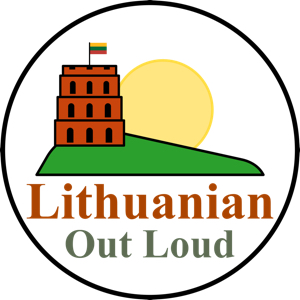
Episode description
Hi there, I’m Jack and I’m Gintarė and welcome back to Lithuanian Out Loud where we offer the world the Lithuanian language.
According to the BBC article, “Lithuanian Jews Revive Yiddish,” before World War II there were over 250,000 Jews in Lithuania. Because of the Nazi Holocaust there are only about 5,000 Jews in the country today and only a few can speak Yiddish. Members of the Lithuanian Jewish community are working hard to revive the language and one of the few places you can still hear Yiddish spoken in public is the Vilnius Choral Synagogue.
Lithuanian Jews revive Yiddish
http://news.bbc.co.uk/2/hi/in_depth/6303057.stm
today we’ll continue exchanging singular nouns with jis or ji depending on gender
in this episode we’ll ask you a question in English such as, “where is the book?” – “kur knyga?”
you respond with, “it is in the room” in Lithuanian, using jis or ji yra kambaryje
to do this you have to keep in mind the gender of the thing we’re talking about
the room
kambarys
in the room
kambaryje
book is a feminine noun so we would replace knyga with ji
basket is a masculine noun so we would replace krepšys with jis
where is the book?
kur yra knyga? ji yra kambaryje
where is the basket?
kur yra krepšys? jis yra kambaryje
here we go…
where is the armchair?
kur yra fotelis? jis yra kambaryje
where is the computer?
kur yra kompiuteris? jis yra kambaryje
where is the television?
kur yra televizorius? jis yra kambaryje
where is the table?
kur yra stalas? jis yra kambaryje
where is the cat?
kur yra katė? ji yra kambaryje
where is the dog?
kur yra šuo? jis yra kambaryje
where is my wallet?
kur yra mano piniginė? ji yra kambaryje
where is the wineglass?
kur yra taurė? ji yra kambaryje
where is the basket?
kur yra krepšys? jis yra kambaryje
where is the letter?
kur yra laiškas? jis yra kambaryje
where is the pizza?
kur yra pica? ji yra kambaryje
where is the bowl?
kur yra dubuo? jis yra kambaryje
when we’re talking about plural objects, we use jie or jos depending on the gender
now, let’s do these same objects in the plural and this time we’ll say - in the kitchen
a kitchen
virtuvė
in the kitchen
virtuvėje
where are the strawberries?
kur yra braškės? jos yra virtuvėje
where are the tables?
kur yra stalai? jie yra virtuvėje
where are the grapes?
kur yra vynuogės? jos yra virtuvėje
where are the nuts?
kur yra riešutai? jie yra virtuvėje
where are the beans?
kur yra pupelės? jos yra virtuvėje
where are the pies?
kur yra pyragai? jie yra virtuvėje
where are the wineglasses?
kur yra vyno taurės? jos yra virtuvėje
where are the baskets?
kur yra krepšiai? jie yra virtuvėje
where are the letters?
kur yra laiškai? jie yra virtuvėje
where are the pizzas?
kur yra picos? jos yra virtuvėje
where are the bowls?
kur yra dubenys? jie yra virtuvėje
now, let’s mix some singular and plural objects and we’ll reply with, in the street
the street
gatvė
in the street
gatvėje
where is the car?
kur yra mašina? ji yra gatvėje
where are the automobiles?
kur yra automobiliai? jie yra gatvėje
where are the bicycles?
kur yra dviračiai? jie yra gatvėje
where is the dog?
kur yra šuo? jis yra gatvėje
where are the dogs?
kur yra šunys? jie yra gatvėje
where is the girl?
kur yra mergina? ji yra gatvėje
where is the woman?
kur yra moteris? ji yra gatvėje
where are the girls?
kur yra merginos? jos yra gatvėje
where are the women?
kur yra moterys? jos yra gatvėje
where is the bicycle?
kur yra dviratis? jis yra gatvėje
now, let’s do some locations and we’ll say they’re in the capital
the capital
sostinė
in the capital
sostinėje
where is the museum?
kur yra muziejus? jis yra sostinėje
where is the cathedral?
kur yra katedra? ji yra sostinėje
where is the hotel?
kur yra viešbutis? jis yra sostinėje
where is the castle?
kur yra pilis? ji yra sostinėje
where is the church?
kur yra bažnyčia? ji yra sostinėje
where is the post office?
kur yra paštas? jis yra sostinėje
where is the coffee shop?
kur yra kavinė? ji yra sostinėje
where is the restaurant?
kur yra restoranas? jis yra sostinėje
where is the shop?
kur yra parduotuvė? ji yra sostinėje
where is the bar?
kur yra baras? jis yra sostinėje
now for a few more examples before we finish for today…
We're traveling to the city. It is called Madrid.
Vykstame į miestą. Jis vadinasi Madridas.
We're traveling to the city. It is called Helsinki
Vykstame į miestą. Jis vadinasi Helsinkis.
We're traveling to the city. It is called Ankara.
Vykstame į miestą. Jis vadinasi Ankara.
Where is the pizza from? It is from the pizzeria.
Iš kur yra pica? Ji yra iš picerijos.
Where is the car from? It is from Germany.
Iš kur yra mašina? Ji yra iš Vokietijos.
Where is the fish from? It is from the river.
Iš kur yra žuvis? Ji yra iš upės.
The farm is for sale. It is in the forest.
Ūkis yra parduodamas. Jis yra miške.
The stone house is for sale. It is in the village.
Parduodamas mūrinis namas. Jis yra miestelyje.
The coffee shop is for sale. It is in Panevėžys.
Kavinė yra parduodama. Ji yra Panevėžyje.
I want the dictionary. Where is it?
Aš noriu žodyno. Kur jis yra?
I want the knife. Where is it?
Aš noriu peilo. Kur jis yra?
I want the bottle. Where is it?
Aš noriu butelio. Kur jis yra?
I want my beer. Where is it?
Noriu savo alaus. Kur jis yra?
I want my wallet. Where is it?
Noriu savo piniginės. Kur ji yra?
I want my keys. Where are they?
Noriu savo raktų. Kur jie yra?
Šaunuoliai! Great! You made it to the end of another episode! Nuostabu!